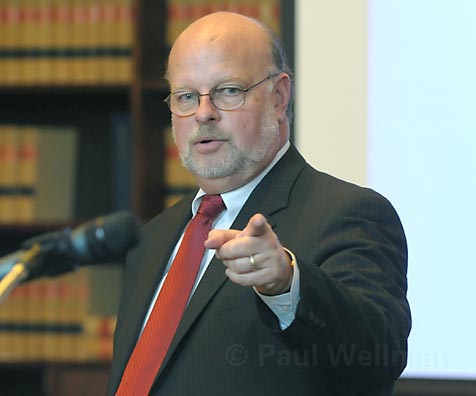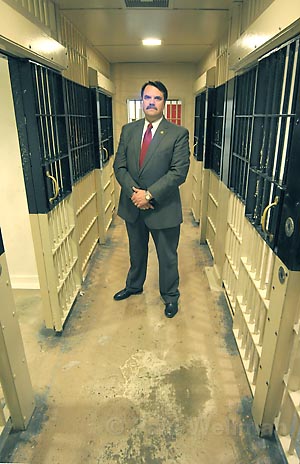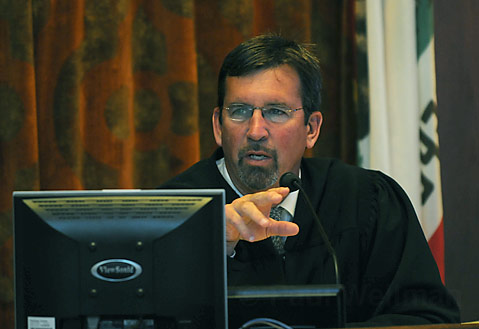Jail Overcrowding Case Postponed
Possibly Fruitful Negotiations Emerge from Contempt Action Against Sheriff Bill Brown

Last week, Judge Brian Hill postponed a contempt of court action against Sheriff Bill Brown on a jail overcrowding case nearly 30 years old to give attorneys representing Brown and the inmates at least a month more to hammer out some sort of voluntary agreement.
Attorney Robert Sanger and public defender Gregory Paraskou brought the contempt action against Brown – who, as sheriff, is responsible for conditions at the County Jail – because the jail still has inmates sleeping on the floors due to overcrowding, and that’s despite a judge’s order in the 1980s to stop this practice. Deputy county counsel Kelly Scott, who represents Brown’s office, contends that while “floor sleeping” does exist – albeit on cots with frames – conditions at the County Jail have vastly improved since the 1980s order by former Judge William Gordon, and no longer constitute “cruel and unusual” punishment.

Neither Sanger nor Scott would comment directly on the nature of negotiations, only to confirm that they are taking place. Despite the length of the case and the seeming intransigence of the parties, Sanger and Scott both expressed some optimism – however guarded – that negotiations might bear some fruit.
Sanger had hoped to expand his contempt action against Sheriff Brown to include the County Board of Supervisors, but was shot down by Judge Hill. Sanger – who was appointed by Brown to his Blue Ribbon Commission on jail overcrowding three years ago – said Brown is doing much to solve a problem not of his making. For example, Sanger argued that if County Mental Health provided 36 beds for mentally ill inmates, the problem of floor sleepers would be solved. In addition, he has chided court administrators for being way too conservative when allowing certain accused individuals to be released on their “own recognizance” (OR) and without bail. Sanger said 70 percent of the inmates in County Jail are poor or without means. Because of this, he said, they have little or no collateral that can be seized should they flee, and court administrators are leery of granting them OR.
The jail overcrowding case is one of the longest running court actions in Santa Barbara. The inmate on whose behalf it was originally filed, convicted murderer Dennis Boyd Miller, is now in his seventies serving life without possibility of parole in Folsom Prison. Sanger said Miller is now seeking a transfer to another facility because of health issues. Miller, who has worked as assistant librarian behind bars, reportedly has an exemplary record, having accrued not a single disciplinary reprimand. Given the extraordinary length of time the Santa Barbara case has taken, it’s anyone’s guess whether Miller will survive to see it come to a conclusion.
When Sanger first filed the case in 1981, the jail was far more intensely overcrowded than it is today, and filthy too. Inmate complaints about bugs in the food or triple bunking were commonplace, yet no one, Sanger said, was willing to brave the fear of reprisal that came with filing an official complaint. Miller – then facing either the death penalty or life without possibility of parole – stepped forward. “‘What have I got to lose?'” he reportedly asked Sanger. After Miller emerged as a complainant in what was filed as a habeas corpus complaint, another prisoner stepped forward with a petition signed by 32 others. But the case achieved critical mass only after a couple of sheriff’s deputies assigned to the jail joined the action, complaining that the jail’s deplorable conditions put them at risk, as well.

While Miller is but a footnote to the legal proceedings now unfolding, it’s a fascinating chapter in the annals of Santa Barbara crime. A native of Washington state at the time, Miller was a Walter Mitty character from the dark side. A man of multiple personas, Miller presented himself to some as a CIA hit man, and he was hired to kill a South African sculptor and diamond smuggler then living in Santa Barbara named Giovanni Schoeman. Miller wound up killing not just Schoeman, but his girlfriend and a business partner as well, shooting them all in the head. To the extent Miller was ever a professional hit man, he was notoriously inept. He had his hair cut shortly before executing Schoeman and company, and left fresh hair clippings at the scene of the crime. In addition, he got the victims’ blood on his boots. He left fingerprints at the Montecito hotel where he stayed. And when detectives searched his home in Washington, they found a box of bullets identical to the ones used in the killings.
The only question left unanswered at the trial was Miller’s motive. Both sides suspected that Miller had been hired by a Seattle resident named Ed Zehner, with whom Schoeman had had bitter business disputes. But Zehner – who ran an art gallery and a hypnotherapy institute in Seattle – was never charged in connection with the crime, let alone prosecuted or convicted. Aside from smuggling diamonds, Schoeman also manufactured fake bronze statues. In fact, he had been commissioned by actor Sylvester Stallone, who then owned property in Santa Barbara, to make a life-size bronze of his character Rocky Balboa duking it out with his nemesis Apollo Creed. At the time, Stallone had hoped the statue would be located in front of City Hall in Philadelphia, where the Rocky films were situated.
Typically, Schoeman would replicate existing statues, using a fa§ade of bronze on the outside, but filling the core with lead shot or fishing weights. Investigators suspected that Zehner and Schoeman had a falling out in the manufacture of phony statues, and that led to Schoeman’s execution. They suspected that Zehner’s girlfriend – who had been arrested for smuggling diamonds concealed in her brassiere – befriended Miller, whom she reportedly met in a Washington bowling alley. But Miller never rolled over on Zehner or his girlfriend, and investigators could never prove the connection.
Miller’s prosecutor had sought the death penalty at the time, but jurors declined, and sentenced him to life instead. At the time, some jurors expressed hope that Miller might one day spill the beans on the parties truly responsible for the triple homicide. To date, Miller has not done so.



